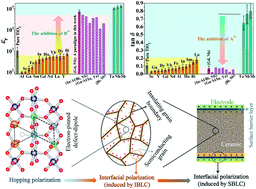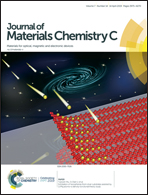Role of trivalent acceptors and pentavalent donors in colossal permittivity of titanium dioxide ceramics
Abstract
Acceptor and donor co-doped titanium dioxide (TiO2) materials have a colossal permittivity (CP), a low dielectric loss, and a good temperature/frequency stability, showing an immense potential for microelectronics and high-energy storage devices. In this study, we propose to decode the role of acceptors and donors on CP dielectric properties in TiO2 by doping a series of A3+ acceptors or B5+ donors. A reduced dielectric loss of tan δ < 0.10 with small permittivity is observed in A3+-TiO2, whereas a CP with εr > 105 is displayed in B5+-TiO2 accompanied by a high dielectric loss (>0.40). Both of them possess an obvious temperature/frequency sensitivity. Inversely, an additive effect with CP and low dielectric loss appears in A3+ and B5+ co-doped TiO2 over a broad temperature/frequency range, e.g., a giant εr value (5.7–9.6 × 104) and a low tan δ value (0.05–0.096) are achieved in a paradigm system of (Gd0.5Nb0.5)xTi1−xO2. The XPS analysis indicates that introducing A3+ causes the appearance of  , while the B5+ substitution can afford an extra electron to transform Ti4+ to Ti3+. The introduced cations and generated defects combine together to form an electron-pinned defect-dipole and cause a strong dipole polarization. These defects can also facilitate the internal barrier layer capacitance and surface barrier layer capacitor effects, leading to a higher CP property.
, while the B5+ substitution can afford an extra electron to transform Ti4+ to Ti3+. The introduced cations and generated defects combine together to form an electron-pinned defect-dipole and cause a strong dipole polarization. These defects can also facilitate the internal barrier layer capacitance and surface barrier layer capacitor effects, leading to a higher CP property.



 Please wait while we load your content...
Please wait while we load your content...